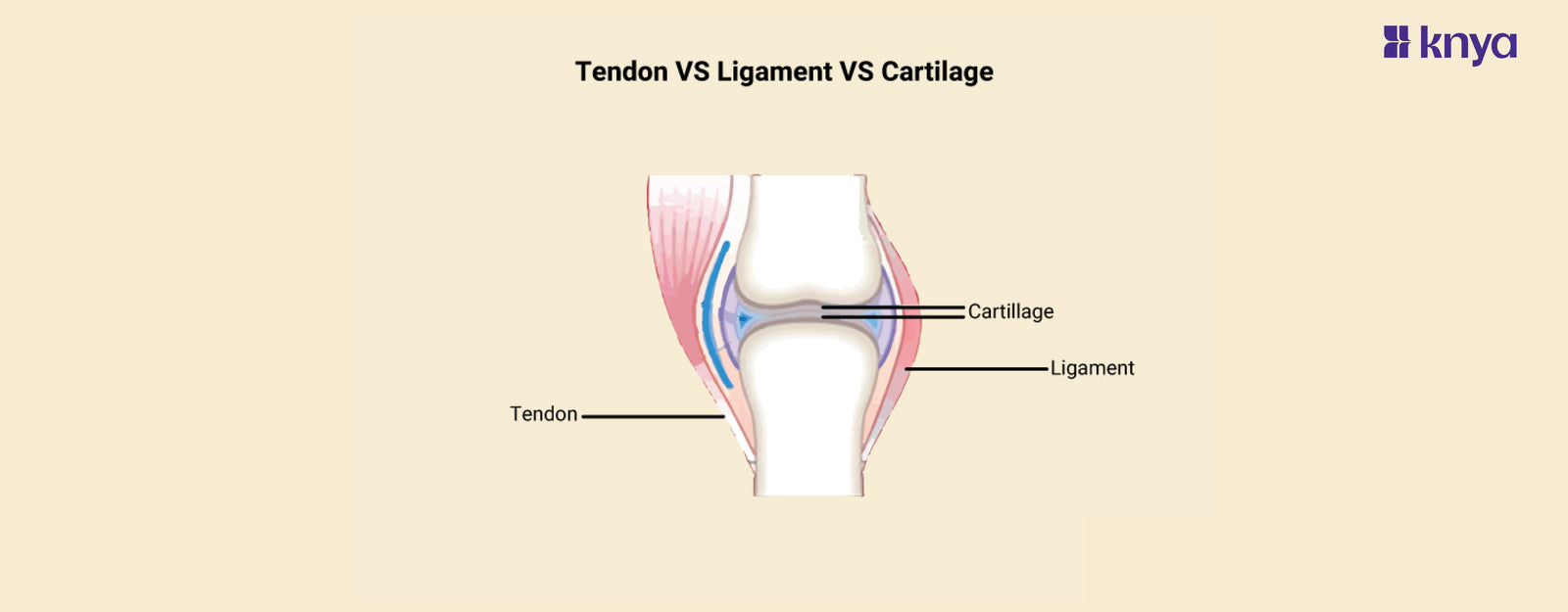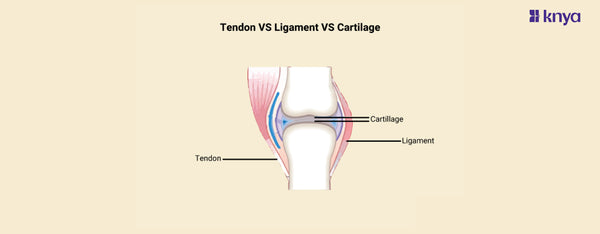Tendon Vs Ligament Vs Cartilage: While all part of the supportive cast for your body's movement, Tendon vs. Ligament vs. Cartilage play unique roles, Tendons are the sturdy cables, connecting muscles to bones, allowing them to pull and move joints. Ligaments are the elastic bands, connecting bone to bone, providing stability and preventing excessive movement. Cartilage acts as the smooth, shock-absorbing pads at joint surfaces, cushioning bones and enabling smooth gliding. So, Tendon for action, Ligament for stability, and Cartilage for cushion, each essential for seamless movement!
Difference Between Tendon, Ligament and Cartilage
Tendons, ligaments, and cartilage are all connective tissues found in the human body, but they serve different functions and have distinct structures. Here are definitions and differences between them:
|
Aspect |
Tendon |
Ligament |
Cartilage |
|
Definition |
Tough, fibrous tissue connecting muscles to bones |
Strong fibrous tissue connecting bones to other bones |
Flexible connective tissue found in various body parts |
|
Function |
Transmits muscle force to bones for movement |
Stabilizes joints, prevents excessive movement |
Provides cushioning, support, and reduces friction in joints |
|
Structure |
Mostly collagen fibers arranged parallel |
Primarily collagen fibers with some elastic fibers |
Chondrocytes embedded in a collagen/proteoglycan matrix |
|
Location |
Connects muscles to bones |
Found in and around joints |
Between bones and in various body structures |
|
Flexibility |
Relatively inflexible |
Relatively inflexible |
Relatively flexible |
|
Blood Supply |
Poor blood supply, slow healing |
Poor blood supply, slow healing |
Lacks blood vessels, limited healing capacity |
|
Healing Capacity |
Can regenerate to some extent |
Can regenerate to some extent |
Limited healing capacity |
|
Appearance |
Fibrous bands |
Fibrous bands |
Gel-like |
|
Attachment Points |
Muscles to bones |
Bones to bones |
Between bones, in various body structures |
|
Injury Types |
Strains or tears |
Sprains or tears |
Damage or degeneration due to wear and tear |
Browse Best Scrubs Collection
What is Tendon?
Tough, fibrous tissue called a tendon joins muscle to bone. It enables you to move your body by transferring the force of a muscle contraction to the bone. Although the body is full of tendons, two of the most well-known are the patellar tendon, which attaches the quadriceps muscle to the kneecap, and the Achilles tendon, which joins the calf muscle to the heel bone.
Key Features of Tendon:
- Connect muscle to bone, transferring force generated by muscle contraction to bones, enabling movement.
- Dense, fibrous connective tissue consisting mainly of tightly packed collagen fibers. Strong but inflexible, resembling cords.
- Found throughout the body, connecting major muscle groups to bones, like biceps tendon connecting bicep muscle to the shoulder.
- Vary in size and strength depending on function. Thicker tendons, like the Achilles tendon, handle larger forces.
What is Ligament?
A ligament is a tough, fibrous tissue that connects bone to bone. It provides stability to joints and prevents them from dislocating. Ligaments are also found all over the body, but some of the most important ones include the anterior cruciate ligament (ACL) in the knee and the medial collateral ligament (MCL) in the elbow.
Key Features of Ligament:
- connect bone to bone, giving the joint stability and preventing excessive mobility.
- fibrous connective tissue that resembles tendons but has more fibres, making it more elastic. Provide flexibility while preserving the integrity of the joint.
- knee ligaments, which stabilise the knee joint and limit excessive side-to-side movement, are found around joints.
- differ in elasticity and size based on the necessities of the joint. While the ligaments in the spine allow for some mobility, the ligaments in the knee are strong and stiff.
What is Cartilage?
Cartilage is a rubbery, gel - like tissue that covers the ends of bones in joints. It works as a cushion, absorbing shock and preventing the bones from rubbing against each other. Cartilage is also found in other parts of the body, such as the ears and the nose.
Key Features of Cartilage:
- As you move, the cushioning of bones at joints absorbs stress and lessens friction. permits painless, seamless joint articulation.
- semi-rigid connective tissue that has a gel-like matrix due to the special combination of collagen fibres and proteoglycans.
- found covering the extremities of bones at the knee joint, or at the ends of bones where they connect in joints.
- There are three different varieties of cartilage: fibrocartilage (strong and shock-absorbing, found in knee menisci), elastic cartilage (flexible, found in ears), and hyaline cartilage (white, smooth, and most prevalent).
Shop Best Lab Coats from Here!
Similarities Between Tendon, Ligament and Cartilage
- Tendons, ligaments, and cartilage are all types of connective tissue.
- They all contain collagen, a fibrous protein that provides strength and structure.
- They all contribute to the structural integrity and function of the musculoskeletal system.
- They protect bones and joints from excessive wear and tear during movement.
- While their specific roles may differ, they all contribute to the overall movement and stability of the body.
- They are all susceptible to injury, whether through overuse, trauma, or degeneration.
- They help maintain the shape and form of various body structures.
- Tendons, ligaments, and cartilage are all found in or around joints, contributing to joint function and stability.
- Collagen is a major component of their structure, providing strength and resilience.
Tendons, ligaments, and cartilage, although all part of the musculoskeletal system, play distinct roles in our body's movement and support. Tendons, the "muscle movers," act as fibrous cables anchoring muscles to bones, enabling force transmission for actions like raising your arm. Ligaments, the "joint stabilizers," are elastic bands connecting bone to bone, providing crucial joint stability and preventing excessive movement. Cartilage, the "joint cushion," acts as a smooth, rubbery padding at joint surfaces, absorbing shock and facilitating frictionless movement. While all are susceptible to injury, understanding their differences is key to recognizing pain and seeking proper treatment for optimal mobility and joint health.
| Check out More Articles | |
| Difference Between Tendon and Ligament | |
| Difference Between Seizure and Epilepsy | |
| Difference Between Hypothyroidism and Hyperthyroidism | |















